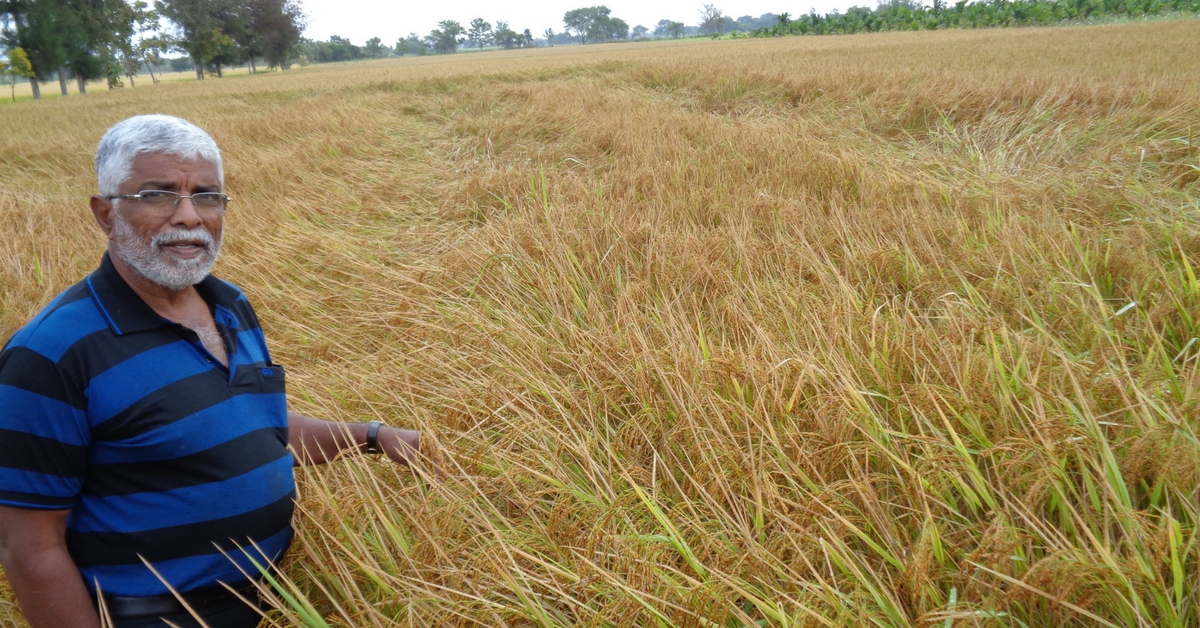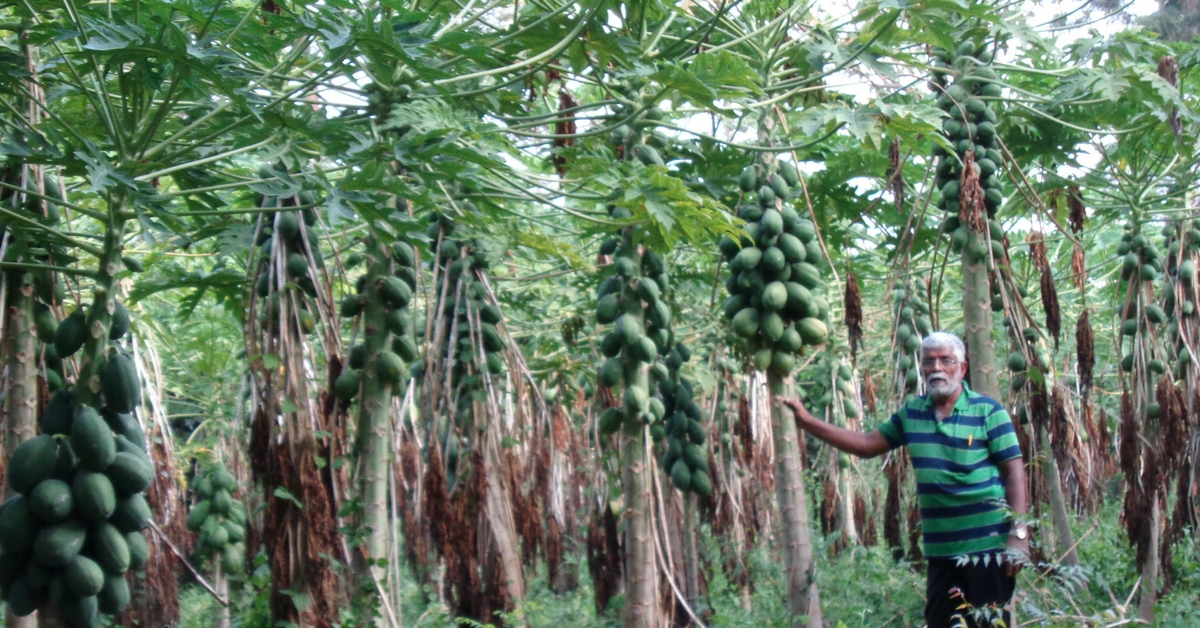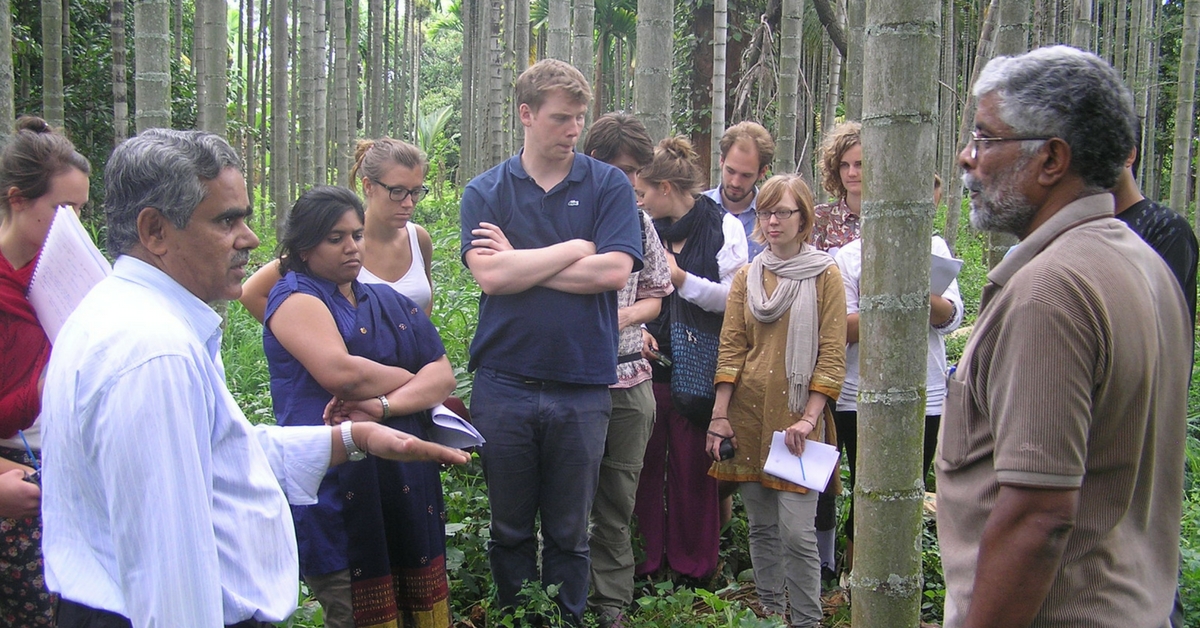Drought Does Not Scare This Farmer. His Unconventional Methods Are Helping Him Survive & Thrive!
Inspired by Masanobu Fukuoka, MK Kailash Murthy took up natural farming in 1988 and hasn't looked back since.

Despite the worst bout of drought hitting the country in decades, a stretch of land in the village of Doddinduvadi thrives with vegetation.
One could consider the possibility that the farmer who owns the land must have been far-sighted and took preventive measures to ensure his crops didn’t fall prey to the drought or maybe he was just plain lucky.
Located in the Kollegal taluk of Chamarajanagar district, Doddinduvadi comes under the regions in Karnataka that have borne the brunt of the drought with miles and miles of barren land.
Amidst this lies retired bank employee MK Kailash Murthy’s 6.5 acres of farmland that is nothing short of an ecosystem in itself.

Following an ecological farming method that involves a “do-nothing” approach, where the term does not refer to lack of effort, but to the complete evasion of manufactured inputs and equipment, Murthy has been able to harvest produce over the years while most farmers were being subjected to crop failure or unyielding harvests.
“Back in the 80s, I used to pursue farming like every other farmer in our country, administering supplements like fertilisers and pesticides as prescribed by agro experts. However, with each year’s paddy harvest, all I could notice was that the yield was depreciating,” Murthy, who had been a bank employee around the time, says.
You may also like: This Farmer Won the Padmashri for His Zero Budget Natural Farming Model
Amid a bleak period of despair that lasted from 1984 to 1988, Murthy tried understanding why this was happening and did a lot of research before stumbling across the book, The One-Straw Revolution.
Authored by Masanobu Fukuoka, a Japanese farmer, philosopher, and the founder of the natural farming method, the concept required one to give up all conventional practices that was associated with farming like tilling, weeding, pruning and use of fertilisers or pesticides.
Intrigued by the method, Murthy decided to give the practice a shot.

“Also, there wasn’t anything to loose anymore. I thought I might as well as try it,” he says.
Starting in 1988, it took two years for the soil in Murthy’s farm to reclaim all of its lost virtues.“After sprinkling the seeds across the field, the land was left to its own device. Except for some basic irrigation, there was nothing else that was provided. In fact, as we proceeded further with natural farming, the groundwater table also started getting stabilised,” he says.
An important aspect of this method is that you let the soil ‘live’ by leaving it on its own. This helps the microbes in the soil to not just grow but also take care of the soil by helping in water retention.
“The soil, without any chemical hindrance or adulteration, is an ecosystem of its own. Chemical farming is one of the major causes that leads to the death of the organisms who have such a significant role to play,” Murthy insists.
Calling out tilling and digging the ground for sowing seeds, he sheds light over the damage caused by one of the most basic farming practices followed since time immemorial.

“Destroying central physical characteristics of soil like water suction and its ability to send moisture upward, tilling has a major role to play towards the destruction of soil horizons and as a result, disrupting the flow of nutrients that happen naturally,” Murthy explains.
Citing artificial lakes and dams as destructive methods for water conservation, he mentions that much of the water content just gets evaporated. “It can’t be reclaimed since the evaporated water heads off to seas, leading to the groundwater table level plummeting even lower,” Murthy adds.
You may also like: How an Engineer Is Taking Zero Budget Natural Farming to Maharashtra’s Farmers
Murthy’s farm is home to almost 3,000 different medicinal plants along with crops of paddy, vegetables and fruits that grow aplenty. In fact, he can’t remember the last time that he had to purchase any fruit that wasn’t grown on his own farm.
“Everything grown here is a result of the sunlight and no other additive. I could proudly say that the entire farming process employed here could be one of the very few that solely depends on the process of photosynthesis. Everything else is taken care of by nature,” he mentions.
Over the years, scientists and agro-enthusiasts from across the world have visited Murthy to see for themselves the wonders of natural farming.

Murthy, who says that his farm has now more or less become a ‘research lab’, says that one fails to understand the amount of damage and abuse the nature is being subjected to, thanks to the conventional methods of farming.
“This type of farming is hardly encouraged since this will become the downfall of the multi-million agro-industry that swears by artificial fertilisers and pesticides. Not only is this method a step closer towards steadying the ecological balance while one still has the opportunity to do so, the perks that follow are multifaceted,” Murthy adds.
To get in touch with MK Kailash Murthy, you can mail him at [email protected].
Like this story? Or have something to share? Write to us: [email protected], or connect with us on Facebook and Twitter.
NEW: Click here to get positive news on WhatsApp!
This story made me
- 97
- 121
- 89
- 167
Tell Us More
We bring stories straight from the heart of India, to inspire millions and create a wave of impact. Our positive movement is growing bigger everyday, and we would love for you to join it.
Please contribute whatever you can, every little penny helps our team in bringing you more stories that support dreams and spread hope.



















